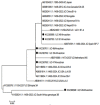Study on JV Virus in Patients with Colon Cancer Type Adenocarcinoma
- PMID: 31030488
- PMCID: PMC6948910
- DOI: 10.31557/APJCP.2019.20.4.1147
Study on JV Virus in Patients with Colon Cancer Type Adenocarcinoma
Abstract
Colorectal cancer is the most repetitious malignancies with high mortality worldwide. JC virus (JCV) is ubiquitous Polyomavirus, with seroprevalence rates ranging from 70% to 90% in adult population. Recently the role of JCV have been reported in many malignant tumors worldwide. The association of JCV was reported in patients with colon and rectum cancers. Thus this study was conducted to evaluate the association of JCV DNA in patients with colon cancer type Adenocarcinoma. Material and Methods: A total of 120 formalin-fixed paraffin-embedded tissue blocks samples were collected including 20/40(50%) males, 20/40(50%) females patients with Colorectal Cancer(CRC), and 80 (50% males, 50% females) patients with benign tumor as a control. DNA was extracted for all the samples. Nested PCR was carried out for detection of Vp1/T-Ag junction genome in JCV genome by Nested-PCR assay. Randomly, PCR products of 6 samples were sequenced to analysis the partial JCV DNA. The phylogeny tree was constructed to determine homology identity with other JCV. Results: 4/40(10%) samples of test group and 10/80 (12.5%) of control samples were positive for JCV DNA (P= 0.69). Out of 4 samples positive for JC DNA, 3(7.5%) were males and 1(2.4%) female (P=0.29). The frequency of JCV DNA in age group> 50 years was 4/32(10%), while in age group <50 years was 0/8 (0%) (p= 0.29). Conclusion: prevalence of JCV DNA was among 10% patients with CRC and 12.5% benign tumors (p=0.69). The distribution of JCV DNA was among 7.5% male and 2.5% female (p= 0.29). The frequency of JCV DNA was among 10% cases of age group >50 years and 0% of age group <50 years (P= 0.29). The subsequent T-Ag protein expression might explain the increased risk of colorectal cancer and requires further investigation.
Keywords: JC virus; colorectal adenocarcinoma; polymerase chine reaction.
Creative Commons Attribution License
Figures


Similar articles
-
Prevalence and genotype identification of human JC virus in colon cancer in Taiwan.J Med Virol. 2008 Oct;80(10):1828-34. doi: 10.1002/jmv.21296. J Med Virol. 2008. PMID: 18712832
-
Detection of a new JCV strain of genotype A in a subpopulation of colorectal adenocarcinomas in Tunisia.New Microbiol. 2017 Apr;40(2):99-106. Epub 2017 Mar 3. New Microbiol. 2017. PMID: 28255604
-
A new evaluation of the rearranged non-coding control region of JC virus in patients with colorectal cancer.BMC Cancer. 2024 Aug 12;24(1):1001. doi: 10.1186/s12885-024-12684-x. BMC Cancer. 2024. PMID: 39134946 Free PMC article.
-
Prevalence of JC and BK viruses in Patients with Colorectal Cancer: A Systematic Review and Meta- Analysis.Asian Pac J Cancer Prev. 2020 Jun 1;21(6):1499-1509. doi: 10.31557/APJCP.2020.21.6.1499. Asian Pac J Cancer Prev. 2020. PMID: 32592342 Free PMC article.
-
JC virus genotyping offers a new paradigm in the study of human populations.Rev Med Virol. 2004 May-Jun;14(3):179-91. doi: 10.1002/rmv.428. Rev Med Virol. 2004. PMID: 15124234 Review.
Cited by
-
Microbiome Differences in Colorectal Cancer Patients and Healthy Individuals: Implications for Vaccine Antigen Discovery.Immunotargets Ther. 2024 Dec 13;13:749-774. doi: 10.2147/ITT.S486731. eCollection 2024. Immunotargets Ther. 2024. PMID: 39698218 Free PMC article. Review.
-
Involvement of HHV-4 (Epstein-Barr Virus) and HHV-5 (Cytomegalovirus) in Inflammatory Bowel Disease and Colorectal Cancer: A Meta-Analysis.Cancers (Basel). 2022 Oct 17;14(20):5085. doi: 10.3390/cancers14205085. Cancers (Basel). 2022. PMID: 36291869 Free PMC article.
-
Prevalence of BK and JC Polyomaviruses among Patients with Breast Cancer.Asian Pac J Cancer Prev. 2024 Mar 1;25(3):821-827. doi: 10.31557/APJCP.2024.25.3.821. Asian Pac J Cancer Prev. 2024. PMID: 38546065 Free PMC article.
-
Prevalence of Human Polyomavirus JC and BK in Normal Population.Asian Pac J Cancer Prev. 2020 Oct 1;21(10):2877-2882. doi: 10.31557/APJCP.2020.21.10.2877. Asian Pac J Cancer Prev. 2020. PMID: 33112543 Free PMC article.
-
Immune Microenvironment and Immunotherapeutic Management in Virus-Associated Digestive System Tumors.Int J Mol Sci. 2022 Nov 6;23(21):13612. doi: 10.3390/ijms232113612. Int J Mol Sci. 2022. PMID: 36362398 Free PMC article. Review.
References
-
- Bouvard V, Baan RA, Grosse Y, et al. Carcinogenicity of malaria and of some polyomaviruses. Lancet Oncol. 2012;13:339–40. - PubMed
-
- Coelho TR, Gaspar R, Figueiredo P, et al. Human JC polyomavirus in normal colorectal mucosa, hyperplastic polyps, sporadic adenomas, and adenocarcinomas in Portugal. J Med Virol. 2013;85:2119–27. - PubMed

